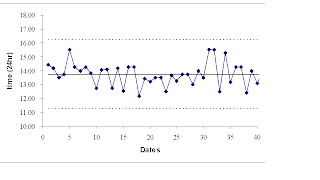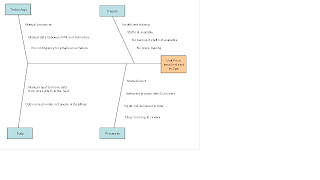Applying a process mindset to the the production and delivery of unit prices can provide a insights into potential improvements. Accuracy and timely delivery are critical to the process with substantial penalties for non-conformance thereby requiring strong process controls.
Fig 1: The Unit Pricing Process in an outsourced environment
Customers define quality as quality of design and conformance quality. In regard to the unit price delivery quality of design relates first to the calculation of the unit price. There are many inputs into the calculation of the unit price and its calculation is governed by standards issued by Financial Services Council (FSC) and subject to review by ASIC. Achieving quality of design is the ability to meet all these standards. The second aspect of quality of design relates to timely delivery as defined by the customer. Conformance quality is associated with being able to deliver to these parameters each day.
The Joiner triangle (Joiner, 1994) provides a model to review how quality is delivered to customers and emphasises that for quality to be delivered it must be measured and that quality is achieved through an empowered workforce. The delivery of quality is essential in regard to the calculation and delivery of unit prices due to the high level of regulation and the high costs incurred for errors. There have been many examples of large compensation payouts for unit pricing errors with the largest being in 2003 when National Australia Bank recompensing customers $67 million for errors that had continued for the past ten years (SMH, 2003).
Figure 2: The Joiner triangle (Joiner, 1994)
In delivering quality the external failure costs are the most visual and the most difficult to estimate. An error may exist for an extensive period before being discovered. Many other costs of quality are less obvious but substantial and include prevention, monitoring and internal failure costs. Although many product issuers outsource the unit pricing process reviews and reconciliations are still required due to the high level of risk in the process. Designing the process, employing and training staff assists in preventing errors however there is a large costs incurred.
Although errors in the process are the most visible aspect they are relatively rare. The area that requires more attention is the other aspect of quality that customers value; the actual delivery of the unit prices to customers each day. The review process must be accurate and meet the requirement for zero errors but it must also meet customer’s requirements for on time delivery.
Measures
Achieving high quality in the unit pricing process requires objective facts about processes and outcomes. The two types of measurement that can be used are outcomes and process measures. Outcome measures are obtained direct from customers regarding their satisfaction. Process measures look at the internal processes their impact on customer satisfaction. Data should be collected on the level of customer expectations, the relative importance of those expectations and the customers’ perceptions of comparisons with competitors.
Table 1 outlines for the unit price process the approach that should be taken to collect the data, the relevant measures.
Table 1: Unit price process measures (Adapted from Berry & Parasuraman, 1997)
1(c) Common & Special Cause Variation
Common causes are those factors and variables that give rise to normal variation, whereas special causes lead to un-normal or unusual variation. Common causes often encompass many small random variations that individually are difficult to isolate and control, but together result in an expected and often predictable range of variation. Although there are many measures that can be chosen for the unit price process delivery time is the most visible and has a high impact on customers if the specification is not met.
Common cause variation is intrinsic to the process and applying this to the delivery time for unit prices this would cover items such as staff training, staff sick leave, staff annual leave, reconciliation differences and delivery delays. As part of the normal process staff resources must be managed. This applies to both the outsource provider and to Schroders. In the normal course of business staff will be on sick or annual leave which can result in the process taking longer. Additionally new staff may need to be trained on the process which again will result in a later delivery. In managing staff resources most of these circumstances are pre-planned and additional resources can be obtained to reduce the variance. Over a certain period there will be a reasonable number of reconciliation differences as a result of the large number of calculations required. Investigation and resolution of these reconciliation differences have the potential to delay the delivery.
Special cause variation arises from specific conditions that occur singularly. Applying this to the delivery time for unit prices this would cover items such as the introduction of new funds, changes in legislation or rules, email server failure, system failure or new customers. As the delivery of the inputs from the outsource provider and the delivery of the final unit prices to customers is by email any failure or delay in email servers will result in late delivery. Changes in legislation of calculation methodology will require changes in processes and additional staff training which initially could lead to later deliveries. Apart for the legislative changes these variations are un-planned and must be dealt with at the time they occur.
To develop conformance quality it is first necessary to eliminate the special causes of variation and develop a stable process. The next step is to then reduce the common cause variation.
Control Chart
Using the delivery time for unit prices to customers an X-chart can be used to track the actual delivery times.
In setting up the control chart the following steps should be followed:
1. Estimate the mean of the data.
2. Calculate the standard deviation of the data.
3. Calculate the upper control limit
4. Calculate the lower control limit
Example of the Control Chart for release of unit price data
Analysis
Using the data above the unit price delivery appears to be a stable process with all data points within the upper and lower control limits. The variations in delivery time appears to be the result of common cause variation however this does not specify how well the process meets customer requirements. In this example customers required that the unit price email be delivered before 2pm and the data collected showed that in many instances this parameter was not being met. Customers do not define a lower specification as they are happy to receive the data earlier, if possible. The lower specification has been set at 11am as this is the earliest the input data could be delivered.
The capability ratio measures the expected number of times the delivery will be outside specifications. This is calculated as:
Cp = (Upper specification – Lower specification)/6σ
Cp = (14:00 – 11:00)/(6 * 0.8)
Cp = 0.60
This would indicate that the variation is less than customers expect however this is only the case if the mean lies close to the centre point of the specification range. For this example the unit pricing process this is not the case. The process capability index, Cpk , defines which of the upper or lower customer specification will likely be breached.
Cpk = min( Upper specification - Χ, Χ - Lower specification)/3σ, 3σ
= min ((14.00 – 13.70)/(3 * 0.8)), ((13.70 – 11.70)/(3 * 0.8))
= 0.10
As the graph shows and this calculation verifies the lower specification will be rarely breached however the upper specification has a high probability of being breached. In this sample it has been breached 18 out of 40 times.
In order to identify the reason the customer specification are not being met a cause and effect diagram can be used.
Cause and effect diagram of the unit price process (Adapted from Slack et al, 1995)
There are three steps within the unit price delivery process being the delivery of inputs from the outsource provider, checking and review by the Product Issuer and then delivery to customers of the final unit price. Further analysis of each step through the use of control charts can identify where the largest variances occur. Reducing these variances is the key to improving the final delivery to the customer. Once a variance is indtified the first step is to remove the special cause variance. The aim is to reduce the processing time in order to meet the final client specifications; therefore the first step is to set some specification for this process (eg mean time for the process should be 30 minutes with and upper limit of 40 minutes and lower limit of 20 minutes). Given these parameters the analysis then needs to concentrate on those days when these parameters were exceeded. Clearly if the process takes longer than 40 minutes there is an issue however taking less time could indicate a lack of integrity in the review process. Reviewing and investigating each observation provides insights into correction.
Working with the outsource provider on their processes presents an opportunity to reduce both special and common cause variance. Rather than treating the processes in each organisation as separate viewing it as the one process would allow efficiencies to be identified. Some of the reviews and checks that Product Issuers complete could be moved to the outsource provider so that when the inputs are delivered minimal processing is required. Although Product issuer needs to maintain responsibility it can achieve this be conducting due diligence on the Service provider processes. This would remove duplication and improve delivery times to the customer.
The process of reducing common cause variation is ongoing and iterative. Reducing variation will in turn reduce the upper and lower control limits resulting in a higher quality and reliable product to be produced.
The unit price process has critical parameters for accuracy and timeliness from the customer’s perspective. Although the requirements for accuracy are being achieved it is essential that deliveries are made within client specifications. Designing a process that delivers quality at a reasonable cost is the goal of Total Quality Management. Designing a quality process is not just contained to within the Product Issuer but requires the process to be treated as a continuous process between the Service provider and the Product Issuer.





No comments:
Post a Comment